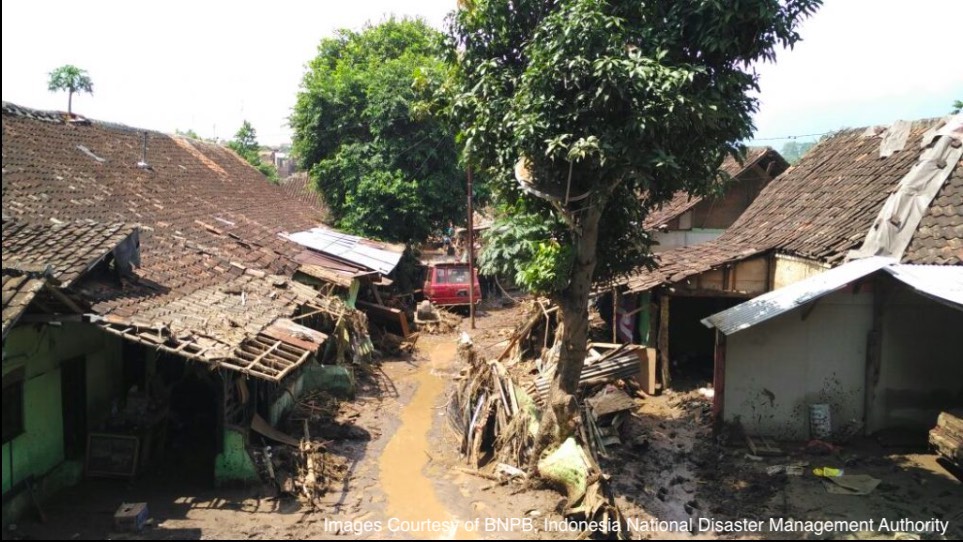 Flooding is one of the most common disasters that Indonesia has historically faced. Many regions throughout Indonesia have struggled with flood management as well as in areas like Bandung City and Garut, located in West Java. For example, between 2009 and 2019, Bandung City experienced 219 flood events (Sagala et al., 2021). The threat of climate change coupled with land-use changes has caused water catchment areas and the level of infiltration to decrease.
Flooding is one of the most common disasters that Indonesia has historically faced. Many regions throughout Indonesia have struggled with flood management as well as in areas like Bandung City and Garut, located in West Java. For example, between 2009 and 2019, Bandung City experienced 219 flood events (Sagala et al., 2021). The threat of climate change coupled with land-use changes has caused water catchment areas and the level of infiltration to decrease.
In Garut, an NGO called Resilience Development Initiative (RDI) is leading the investigation on the impact of flash floods near the Cimanuk River. RDI is locally based in Bandung, Garut’s neighboring region, and this investigation is a part of the "Making Displacement Safer: Locally-led DRR Solutions for Displaced Population in Urban Areas" project (Adianta, 2021). The project is funded by USAID Bureau of Humanitarian Assistance. From their investigation, RDI reports that recent floods in the area has forced about 2,525 people to evacuate from their homes, forcing them to move to 10 designated relocation sited created by the government (Adianta, 2021).
The initial RDI survey found a few challenges that these impacted communities face. One challenge is that some communities or members of communities may not be able to or willing to relocate to the designated displacement site. Many chose to stay in the flood zone because of their belongings and property and others chose to stay because their place of employment and income source are close to the flood zones (Adianta, 2021). Other challenges also arise when mapping out the data for these communities due to a lack of local capacities in data management. The lack of sufficient data collection and management presented challenges in knowing how many communities relocated to the displacement sites and how many people relocated or stayed put in their homes (Adianta, 2021). This lack of data management at the relocation site may raise some concerns later on for developing appropriate Disaster Risk Reduction (DRR) solutions.
On the other hand, RDI reported that Bandung City, West Java’s capital, has created plans for Flood Risk Reduction focused on Nature-Based Solution Framework. According to IUCN, Nature-based Solutions (NbS) are efforts to tackle social problems through preserving and sustainably managing ecosystems in a way that offers human well-being and advantages of biodiversity. One component of Bandung City’s NbS plans is the creation of a sustainable drainage system, since 30% of roads in Bandung City still lacked proper drainage channels and many micro drainage systems are often not complete (Sagala et al, 2021). The aims of the project are to channel rainwater and rid excess surface water by improving existing micro drainage system and taking advantage of macro drainage systems (i.e. rivers). Activities include cleaning up rivers and controlling riverbanks’ land management activities (Sagala et al, 2021). Other Bandung City projects include building retention ponds. These ponds hold large volumes of water and aim to break the high water flow of certain rivers that frequently cause floods (Sagala et al., 2021). These retention ponds may even provide opportunities to contribute to the local economy communities by offering recreational areas surrounding the ponds with jogging tracks or developing tourism sites (Sagala et al, 2021). Additionally, the creation of bio-pore infiltration holes in flood prone regions is also a part of Bandung City Government’s effort of flood risk reduction. Bio-pores are underground holes created to store organic waste; they are layered by cylindrical plastic pipes and are usually 10 cm in diameter and 100 cm in depth. The organic waste planted in bio-pores underground holes will allow for the soil to absorb water up to 40 times more effectively than in soil without bio-pores (Sagala et al. 2021). It will be interesting to see the lessons and mitigation efforts that the broader district of Garut can learn from Bandung City.
Unfortunately, with the continued rise of COVID-19 cases in Indonesia, specifically in Java and Bali, these regions are entering another lockdown and experiencing emergency measures set forth by the government. On July 7th, Indonesia recorded 34,379 new cases and 1,040 deaths within a single day, the country’s highest rate of cases and death since the start of the pandemic. The Delta variant is becoming more prominent in the regions and this has put a strain in their healthcare system as many hospitals are at full capacity and are forced to turn away patients or struggle with giving essential oxygen supplies. This may put a halt or slow down the construction of some of the current flood mitigation systems and push certain development activities and projects in Indonesia, such as in Bandung and Garut, to be completed remotely as done during previous lockdowns. We do not know yet how these indirect impacts of COVID-19 will affect flood disaster planning, response and recovery in these Bandung communities in the future.
References:
Sagala, S., Pranindita, N., Azhari, D., Siregar, N., Widhastri, A., Kanai, J., Lechner, A. (2021). Policy Response to Flood Risk Reduction in Bandung City Indonesia. RDI White Paper Series, 3-18
Adianta, A. (2021, June 9). Resilience of Displaced Urban Community Survey in Garut Area. Resilience Development Initiative.


